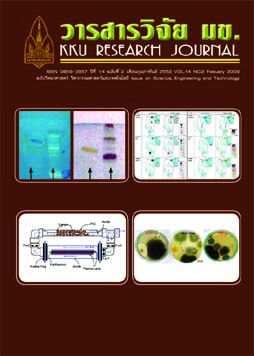Insecticidal activity of Stemona Tuberose Lour extract (Thai)
Main Article Content
Abstract
Nontaiyak (Stemona tuberose Lour: Stemonaceae) is identified as a medical herbaceous plant. The plant root contains alkaloid and isoflavonoid active ingredient substances. In this work, the root of the plant was sequentially extracted with a Soxhlet apparatus by hexane, dichloromethane and 70% methanol. The extracts were studied for their insecticidal activities. The tests were carried out by 1) a feeding leaf disc tested on the larvae of Spodoptera litura Hubner 2) a residual film tested on adult Sitophilus zeamais Motschulsky and 3) an aqueous dispersion tested on the larvae of Aedes aegypti Linnaeus, after test of crude extract on insects for 24 hours. Dichloromethane crude extract gave the highest mortality rate on S. litura and Ae. aegypti. For the S. zeamais toxicity test, the 70% methanol extract gave the highest rate. After fractional extraction of dichloromethane crude extract by column chromatography and subsequently differentiated fractions using the Thin Layer Chromatography (TLC) 9 fractions were obtained from crude extract. F6 and F7 are the fractions which responded at the lowest LC50 values with 13 and 14 ppm, respectively. Detection of the active component under the TLC technique was compared to purified rotenone, but the active component responsible was not rotenone but another component. The component had high efficacy for killing Ae. aegypti. It is concluded from this study that dichloromethane crude extract from S. tuberosa root has high potential for practical application as a natural insect control agent.


